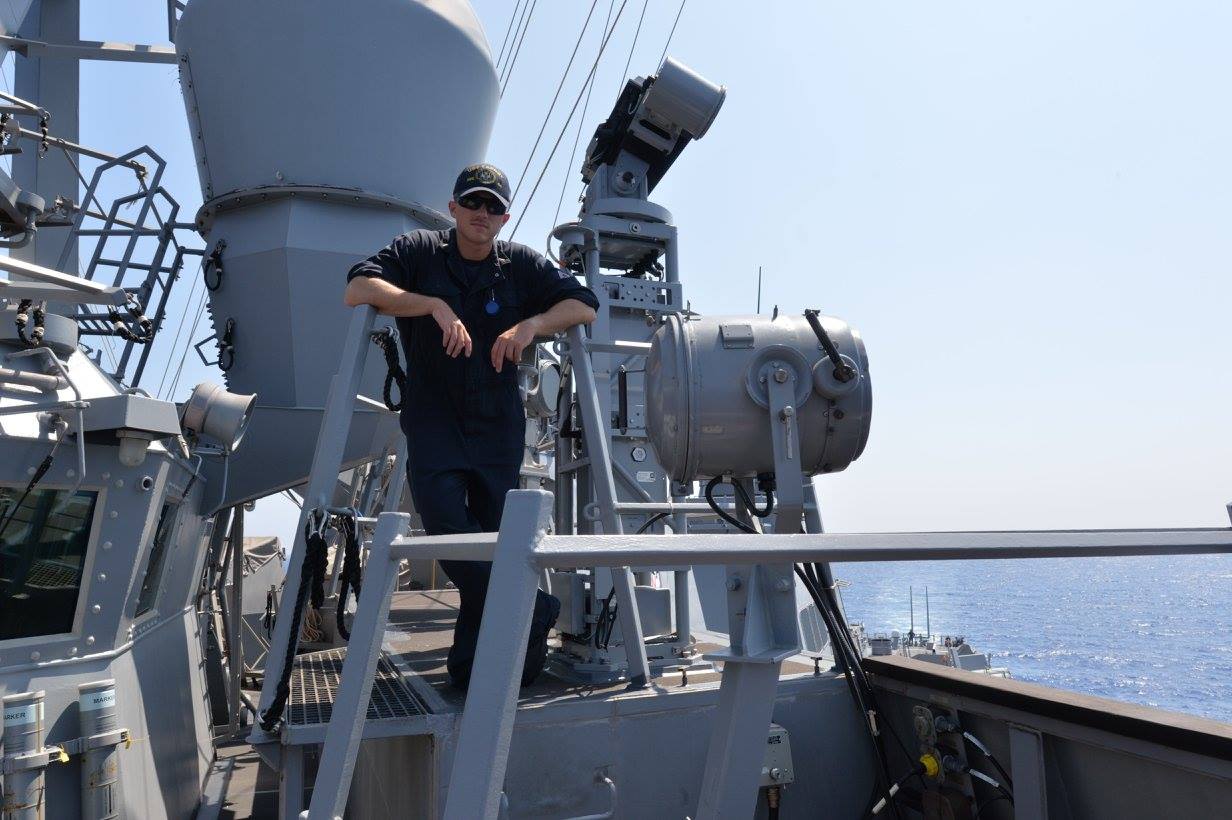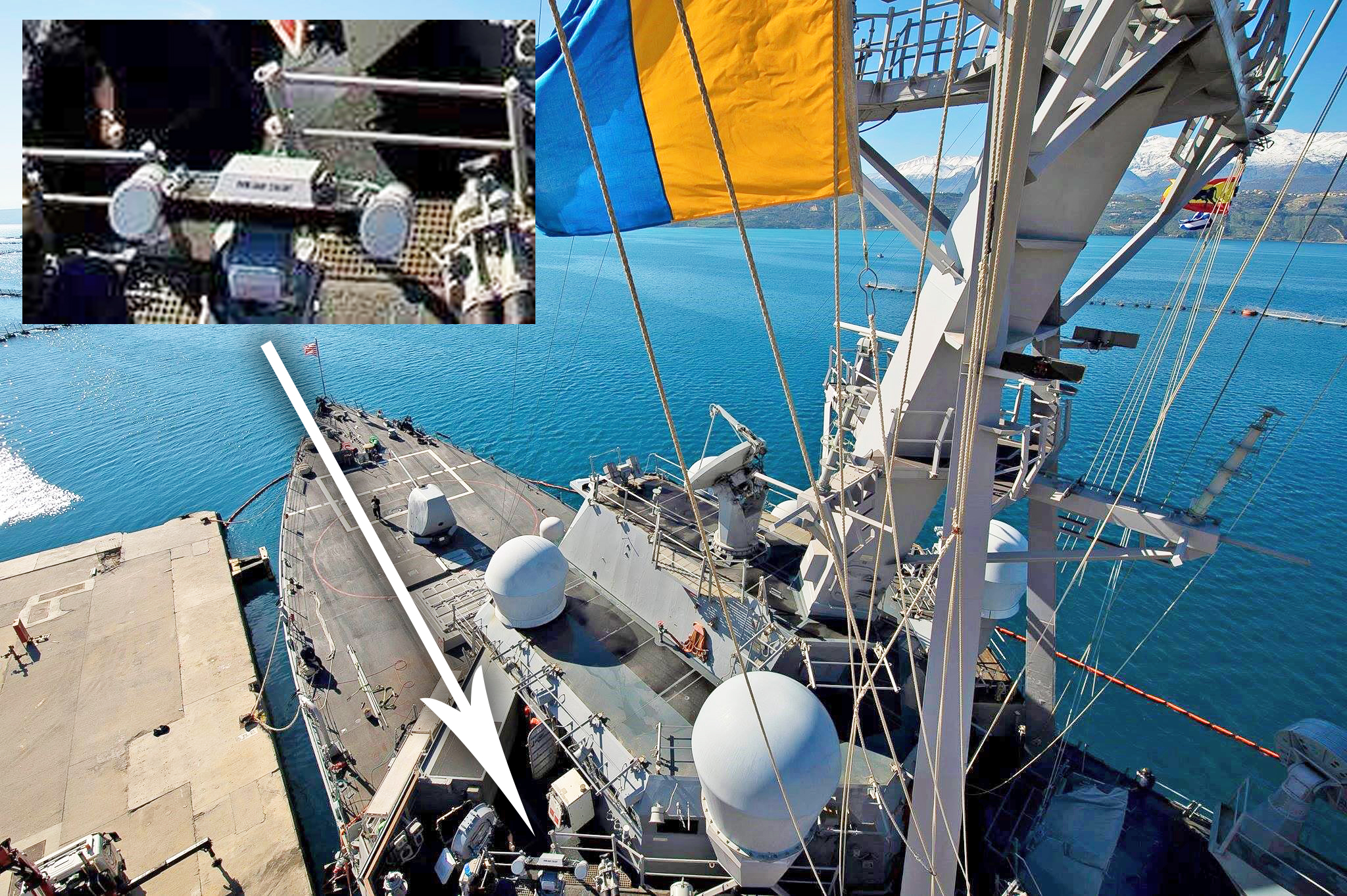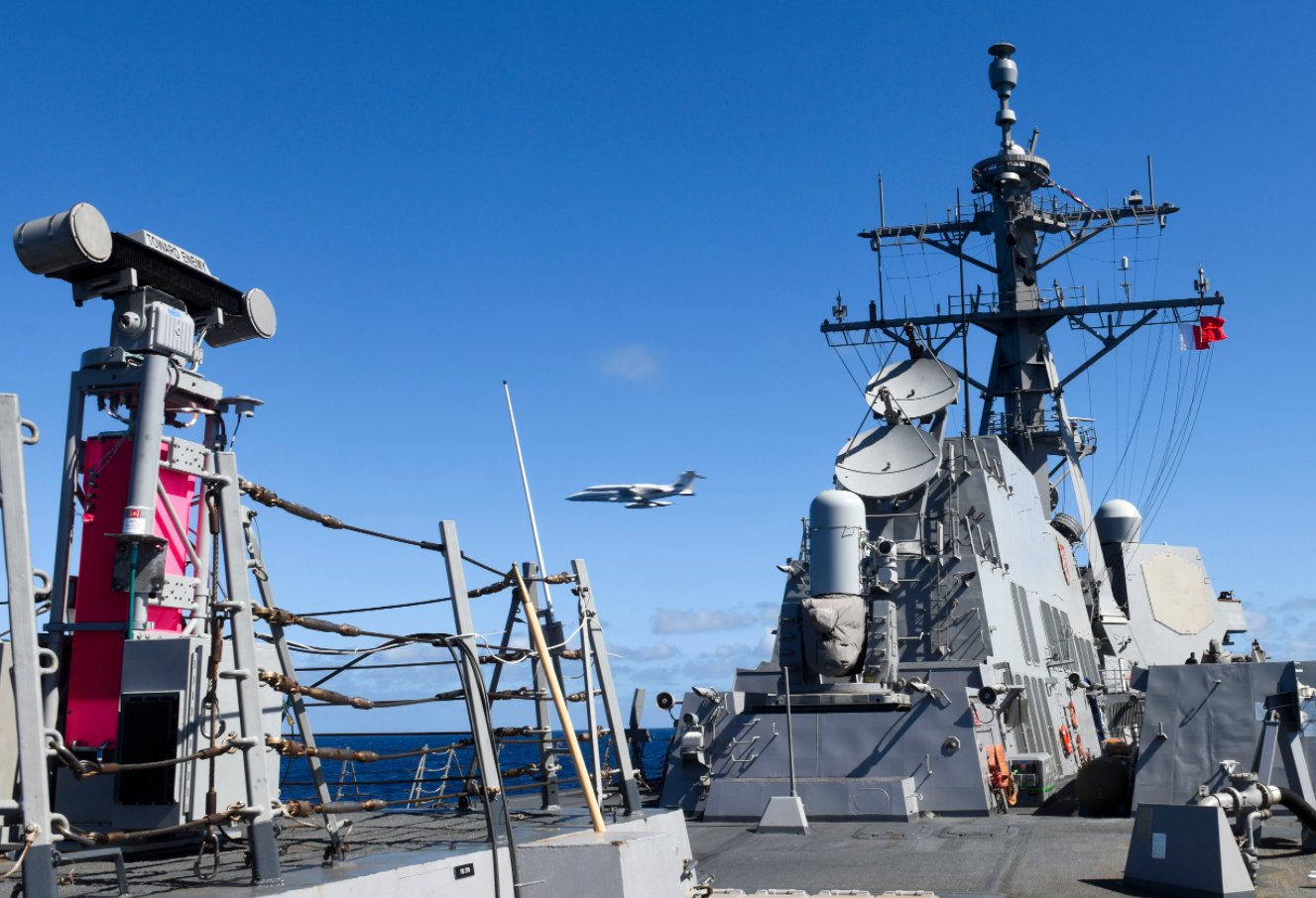The U.S. Navy’s quartet of Arleigh Burke class destroyers that are forward-deployed to Rota, Spain, and makeup Destroyer Squadron 60, sport a unique configuration. The most notable alteration is the inclusion of the self-contained SeaRAM Rolling Airframe Missile launcher system on the ships’ rear pedestal mount. This is in addition to the Phalanx Close-In Weapon System located on their bows. It was installed to beef-up the destroyers’ defenses against advanced anti-ship cruise missiles due to the high-threat areas they would be regularly operating in—especially the Black Sea, which is a nearly land-locked super anti-ship missile engagement zone. They were also among the first to receive an upgraded SEWIP Block II electronic warfare suite. But another unique and so far totally overlooked enhancement involves a far more obscure electronic warfare system, one that, as far as we know, is totally unique to these vessels.
We noticed the funky, WALL-E-looking installations on the bridge wings of USS Porter and USS Donald Cook as they exited the Black Sea through the Bosphorus, which provides a link to the Sea of Marmara, and from there to the Mediterranean, recently. They had deployed to the tense body of water sequentially, and along with a support ship, they represented the biggest U.S. Navy presence in the Black Sea in years while operating together.

Upon closer review, the odd installations have been there for a number of years, on all the forward-deployed destroyers that call Rota home. In fact, they seemed to have appeared around the same time these vessels received SeaRAM as part of their unique upgrade program. So, these are at least semi-permanent installations, but we still weren’t sure what they actually did.
At first, we thought they were an electro-optical/infrared (EO/IR) system, as it seemed similar in basic configuration to other existing EO/IR systems deployed aboard U.S. Navy vessels. It is also worth noting that the Arleigh Burke class was designed with one of the most powerful EO/IR systems around, which you can read more about in this past piece of ours. After more closely examining images of this mystery system, the depth of its ‘cans’ seemed too shallow.

Laser range finders and dazzlers were other possibilities, as well as some sort of directional, turreted electronic warfare system we weren’t aware of. We enlisted a number of contacts to help solve the mystery. Our friends over at Naval News were especially helpful. It turns out that this is indeed an electronic warfare system, one we only really knew the designation of, until now.
This system appears to be the elusive AN/SLQ-62 TEWM-STF (Transportable Electronic Warfare Module-Speed To Fleet) that we discussed as a counterpart to the AN/SLQ-59, another new electronic warfare system that we detailed in August 2019, which is found on ships deployed to the Western Pacific as part the 7th Fleet.
At the time we wrote:
Another similar tailored system is being developed for the 6th Fleet, although it is unclear what physical form it will take. As it sits now, enclosures similar to those used on the AN/SLQ-59 have not appeared on any of the vessels assigned to the region, at least as far as we have seen. Regardless, this 6th Fleet-focused system is designated the AN/SLQ-62.
Official budget documents confirmed this designation and the AN/ALQ-62’s 6th fleet exclusivity.

Our friends at Naval News alerted us to one eagle-eyed Taiwanese naval warfare aficionado that tweeted about this system just a few months ago. @hone_hone_bone_ also noted that the system in question, referred to by its general Transportable Electronic Warfare Module name, appeared as part of a 2017 Navy Research Lab review about a worker who helped develop it:
The system had been in development since around the early part of the 2010s and was focused on bringing tailorable and modular electronic warfare solutions to the fleet rapidly. A version of it was tested during RIMPAC 2016, as seen in the photo below:

So, it would seem that after a year and a half of wondering, we finally know what the AN/SLQ-62 is, and it appears to have been fielded around 2015, but the question remained, what does it do exactly? Is the highly directional, steerable system meant to counter drones? Certain types of missiles? Or something else?
Our own Joseph Trevithick quickly found an openly published mention of the AN/SLQ-62 that points to its intended use—countering anti-ship cruise missiles. This would also match with the publicized image above. The passage comes from an open-source Navy bibliography of relevant documents for anyone preparing to take the E-6 exam for the rating CTT, or Cryptologic Technician (Technical). It reads, in part [link was taken down as the exam date passed]:
TB-EW-01-18 AN/SLQ-62-MK-59 AND NULKA X TACTICS FOR THE SYRIAN SS-N-26/SSC-5 YAKHONT MISSILE, (U) TB-EW-01-18 AN/SLQ-62-MK-59 AND NULKA X TACTICS FOR THE SYRIAN SS-N-26/SSC-5 YAKHONT MISSILE; CHAPTER 2
The entry here describes multiple countermeasures employed to defeat one specific missile, the SS-N-26. These include the launch of Nulka active electronic-warfare decoys and Mk59 passive inflatable decoys, the latter of which you can read all about here, as well as bringing AN/SLQ-62 to bear on the threat. This doesn’t mean SLQ-62 is specifically used to counter just this threat, not in the least, and there are likely classified countermeasures in place as well, but this is the example listed as one potential eventuality on the preparations for the exam.

The SS-N-26 “Strobile,” also known as the P-800 Oniks, is uniquely relevant to the Rota-deployed destroyers as it is one of Russia’s most capable and numerous anti-ship missiles, existing in submarine, ship, and shore-launched versions, the latter of which is fired from the Bastion Coastal Defense System. The ramjet-powered missile is capable of hitting Mach 2.5 and has a range of at least 175 miles (export model), with significantly greater ranges claimed on other variants. The missile also served as the basis for the Russian-Indian BahMos supersonic anti-ship missile.
The export version, mentioned in the passage from the Navy guide above, is called Yakhont, 72 of which were sold to Syria in the late 2000s. The missiles are thought to have been upgraded not long after delivery with a more advanced active radar seeker, making them by far the most capable anti-ship weapons in Syria’s inventory and a threat to ships operating in the far eastern edge of the Mediterranean.
Syria is just one part of the equation. Russia has Strobiles aboard its most advanced ships in its Black Sea Fleet and Bastion systems line the coastlines of Crimea and Russia, helping to create what is a massive anti-access umbrella over much of the Black Sea. Basically, combined with all the other anti-ship missiles—air, submarine, land, and ship-launched—it has in the region, Russia can turn the entire Black Sea into a super anti-ship missile engagement zone, potentially overwhelming even the most advanced warships’ defenses. As such, unique protection from these threats is especially key for the American destroyers that will spend much of their time cruising the eastern Mediterranean and the Black Sea.

Unsurprisingly, information as to how the system works or differs from other electronic warfare capabilities is not publically available. Regardless, we know it was meant to be easily upgradeable and Navy budget documents state it was slated for an upgrade in 2017, which would have only made it more effective at doing what it does, how ever it does it.
It wouldn’t be surprising to see the AN/SLQ-62 show up on other U.S. warships in the future as it was meant to be adaptable and easily transferable if need be. At the same time, the Navy is preparing for SEWIP Block III, which will represent a massive boost in electronic warfare capability and will be more adaptable to new technologies than its predecessor. It isn’t clear if SEWIP Block III, with its active jamming technology, would displace the AN/SLQ-62 and when—or even if—the Flight I Arleigh Burke class destroyers deployed to Rota will receive that upgrade, which you can read more about here. This is all part of a major reinvestment into electronic warfare by the Navy which includes the development of next-generation systems that will be potentially interconnected and capable of some truly amazing things.
In the meantime, America’s destroyers deployed to Spain remain the most heavily protected and most capable of slugging it out in tighter bodies of water than any other warships in America’s fleet, thanks in part to the AN/SLQ-62.
Contact the author: Tyler@thedrive.com
